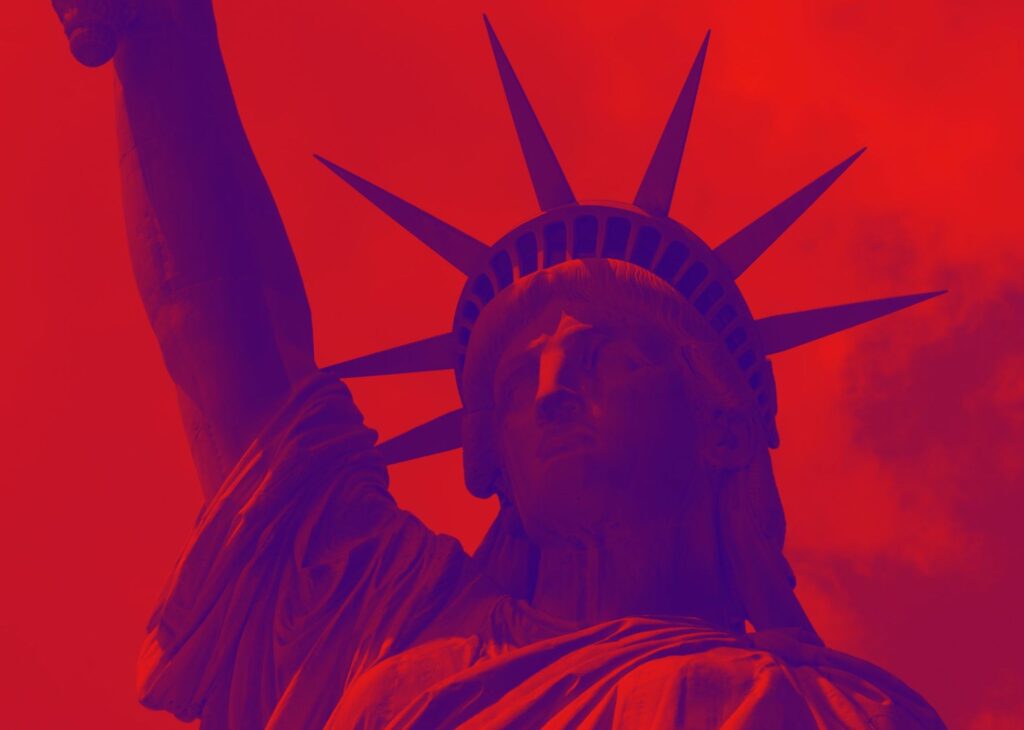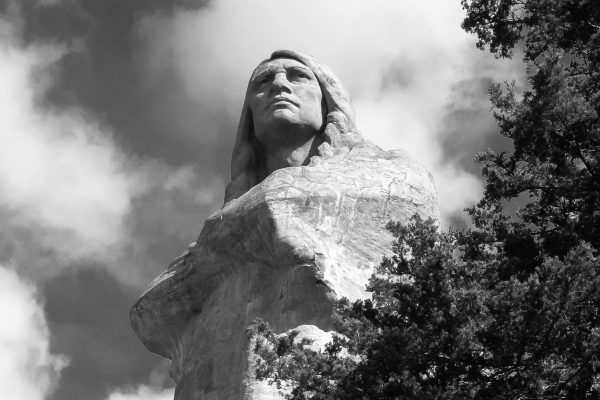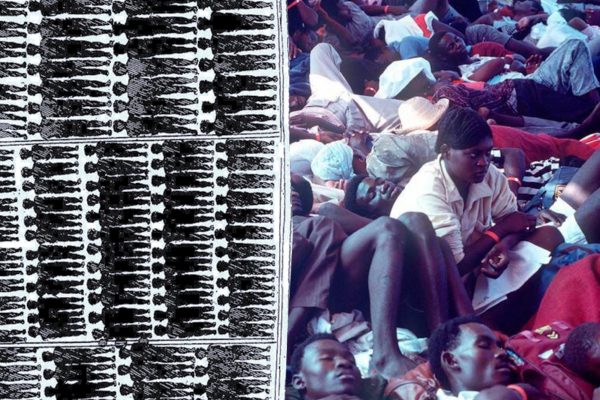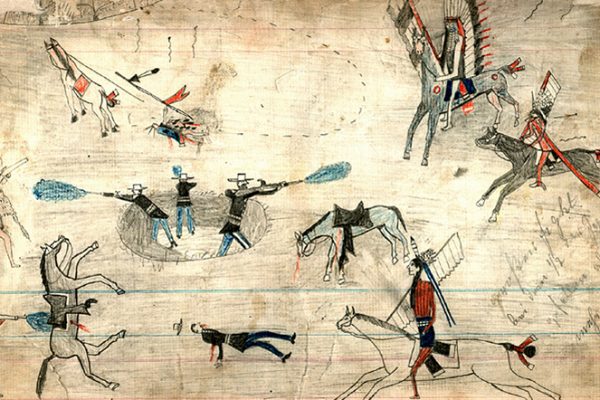The United States has never been “a nation of immigrants.” It has always been a settler state with a core of descendants from the original colonial settlers, that is, primarily Anglo-Saxons, Scots, Irish, and Germans. The vortex of settler colonialism sucked immigrants through a kind of seasoning process of Americanization—not as rigid and organized as the “seasoning” of Africans, which rendered them into human commodities, but effective nevertheless.
In the 1960s, U.S. historians were having to adjust the historical narrative of the white republic and progress in response to Black civil rights demands for a reckoning about racism. But in the process of those adjustments and reforms, the settler state was never a subject of debate. Mahmood Mamdani writes:
If America’s greatest social successes have been registered on the frontier of race, the same cannot be said of the frontier of colonialism. If the race question marks the cutting edge of American reform the native question highlights the limits of that reform. The thrust of American struggles has been to deracialize but not to decolonize. A deracialized America still remains a settler society and a settler state.
Attempts to “include” Native peoples as victims of racism further camouflages settler colonialism and constitutes a type of social genocide. The U.S. polity has been trying to rid itself of Indigenous nations since first settlement. Four hundred years later, multiculturalism is the mechanism for avoiding acknowledgment of settler colonialism. Mamdani correctly observes that the very existence of Indigenous nations “constitutes a claim on land and therefore a critique of settler sovereignty and an obstacle to the settler economy.”
Multiculturalism was the response to civil rights demands, which required a revised narrative of U.S. history. For this scheme to work—and affirm U.S. historical progress—Indigenous nations and communities had to be left out of the picture or somehow woven into the story. As territorially and treaty-based peoples in North America, they do not fit the grid of multiculturalism, but were included by transforming them into an inchoate, oppressed racial group, while oppressed Mexican Americans and colonized Puerto Ricans were dissolved into another such group, variously called “Hispanic” or “Latino,” and more recently “Latinx.” The multicultural approach emphasized the “contributions” of oppressed groups and immigrants to the United States’ presumed greatness. Indigenous peoples were thus credited with contributing corn, beans, buckskin, log cabins, parkas, maple syrup, canoes, hundreds of place names, ecology, Thanksgiving, and even contributing to the Constitution the concepts of democracy and federalism.
This idea of the gift-giving Indian helping to establish and enrich the development of the United States is a screen that obscures the fact that the very existence of the country is a result of the looting of an entire continent and its resources, reducing the Indigenous population, and forcibly relocating and incarcerating them in reservations. The fundamental unresolved issues of Indigenous lands, treaties, and sovereignty could not but scuttle the premises of multiculturalism for Native Americans. Multiculturalism persisted into the neoliberal twenty-first century, culminating in widespread “diversity” training, the coining of a new term, “people of color,” and the production of Hamilton, which not only erased the Indigenous peoples and African slavery but also turned the white founding fathers, who authored a Constitution that recognized only white people as citizens, into brown and Black men.
The Black Power and women’s liberation movements of the 1960s gave birth to “identity politics,” which saw the coalescence of Mexican American youth as Chicanos, Native American Red Power, and a trans-Asian Pacific American identity. A generation that came to adulthood in the 1960s who could not speak Chinese or Spanish, as their immigrant parents felt it might hold their children back, embraced bilingualism. European immigrants or second-generation U.S. Americans, whose parents and grandparents had strived so hard to be considered white, saw the cultural power of whiteness diminishing and began to hyphenate their identity as Polish American, Italian American, and Irish American, while white Appalachians and New Mexico Hispano settlers claimed indigeneity. Instead of the melting pot that erased ethnic heritage, there was talk of patchwork quilts and threads, multiculturalism and diversity.
Immigration in the new millennium looked different from past immigration in that Asia was the major region of origin rather than Latin America, at 41 percent of all immigrants, with 38.9 percent from Latin America, primarily Mexico. Between 2000 and 2017, the top three countries of origin were China, India, and Pakistan, followed by the Philippines. Most importantly, nearly half of the new immigrants were college graduates, many with advanced degrees. They were not heading only to Silicon Valley or other high-tech industrial centers, nor were they, as had immigrants in the past, settling mainly in the large coastal cities. Rather, they could be found in the Deep South, the Great Plains, the intermountain West, and Appalachia. In North Dakota, where immigrants represented about 4 percent of residents, immigrant numbers increased by 87 percent after 2010, while West Virginia and South Dakota increased in foreign- born residents by a third, and Kentucky and Tennessee by over a fifth. And many of these immigrants—some of whom were refugees, others undocumented—came not only from South, West, and East Asia but also from African and Arab countries, the Caribbean, and Central and South America. Like the Chinese and Mexican immigrants before them, they experienced racialization, thereby lacking a key element of settler colonialism: potential whiteness. They or their children could become thoroughly Americanized but still remain contingent, even the son of a Kenyan who was twice elected president but whose citizenship was questioned by a substantial part of the population, including by the president who followed him.
The trend of “third world” immigration began with the 1965 immigration law, but accelerated with the Western nations’ retreat from funding and supporting decolonization and nation-building, which accelerated debt, austerity, and famine, and, in the case of the United States, fronting and arming counterinsurgencies to prevent authentic self-determination, making the countries of origin unlivable. Suketu Mehta immigrated with his family from Mumbai at age fourteen. A prize-winning author and associate professor of journalism at New York University, he observes in his book This Land Is Our Land: An Immigrant’s Manifesto (2019) that “they are here because you were there.” He corrects the idea that immigrants clamor to leave their homelands to pursue the American Dream.
When migrants move, it’s not out of idle fancy, or because they hate their homelands, or to plunder the countries they come to, or even (most often) to strike it rich. They move—as my grandfather knew—because the accumulated burdens of history have rendered their homelands less and less habitable.
Mehta questions the presumed U.S. reader to consider how frequently the U.S. military has gone over its southern border or into the Caribbean or Southeast Asia, or gone over the borders of Iraq or Afghanistan.
The United States has not acted lawfully with other nations, including the Native American nations on its soil, through most of the nineteenth and twentieth centuries. How can it now expect the human victims of that enormous illegality to obey the laws of the United States and stay home or wait thirty years for a visa to rejoin their families?
Mehta proposes that the United States (and other Western countries) pay reparations:
If the rich countries don’t want the poor countries to migrate, then there’s another solution. Pay them what they’re owed. Pay the costs of colonialism, of the wars you imposed on them, of the inequality you’ve built into the world order, and the carbon you’ve put into the atmosphere. Settle the account, and the creditors will have no reason to come to your house. Reparations or migration: choose.
Mehta points out that migrants, as we have seen with Mexican and Philippine migrants, send back to their home countries some $600 billion in remittances every year, amounting to four times more than all the Western foreign aid and a hundred times more than the amount of all debt relief. In addition to the ruin wrought by European colonization and U.S. wars and interventions, plus extreme economic inequality, Mehta sees catastrophic climate change as a source of mass migrations in the twenty-first century, displacing far more people than were displaced at the end of World War II. By 2050 up to 30 percent of the planet’s surface could be unlivable desert, forcing a 1.5 billion people into migration. In Bangladesh alone, 20 million people could be forced out due to rising sea levels, and by the end of the century, the lands of 650 million people could be underwater. Obviously, rich countries will be increasingly a destination for desperate migrants and need to plan to provide assistance, not build walls or increase mass deportations.
Mehta’s manifesto is deeply researched and insightful and should be a refreshing rejoinder to the American Dream and bootstrap stories that many immigrants, and more Anglo settlers, are asked to tell themselves. But Mehta does characterize the United States as “a nation of immigrants” that does not live up to that aspiration. Although he is critical of U.S. imperialism and immigration policies, Mehta does not acknowledge settler colonialism and the immigrant’s role in perpetuating it. The Native is mentioned as an oppressed demographic, but otherwise is invisible.
Moroccan Muslim immigrant Laila Lalami, a prize-winning novelist, writer, and university professor, aptly titled her 2020 book Conditional Citizens: On Belonging in America. She was born in Rabat, Morocco; was educated in Morocco, Great Britain, and the United States; married a U.S. citizen; and was naturalized in 2000. Lalami relates that she had no trouble with the citizenship test, because before she came to the United States, she had taken courses on U.S. history, had studied its literature, and had become acquainted with the culture.
She discovered quickly on arrival in the United States that the Americans she met knew nothing of her country’s history or culture, although they knew the racist caricatures of Arabs and Muslims. As an immigrant, a woman, an Arab, and a Muslim, Lalami was made to feel like a “conditional citizen.” That feeling escalated with the Al Qaeda attacks on the World Trade Center and the Pentagon on September 11, 2001, because the nineteen airplane hijackers were all Muslim, all but one from U.S.-allied Saudi Arabia. The U.S. revenge war in Afghanistan was framed as anti-Muslim—as was the 2003 invasion of Iraq, where, in fact, there was little hardline Islam and no terror attacks by Iraqis. As that heated anti-Muslim period abated somewhat, Lalami was disturbed by the citizen birthright rhetoric that began with the presidency of Barack Obama, who was the target of the “birther” craze claiming that Obama was a secret Muslim actually born in Kenya, making him ineligible for the presidency. The instigator of this false charge, real-estate mogul Donald Trump, ascended to the presidency in 2017 largely on birtherism and his attacks on Muslim and Mexican immigrants. As one of his first acts as president, he banned visitors and immigrants from some Muslim-majority countries by executive order. In a chapter titled “Assimilation,” Lalami insightfully discusses the U.S. nineteenth-century programs to erase the languages, cultures, and social relations practiced by Indigenous peoples, citing the mandatory boarding schools that took Native children from their families and communities. She is alert to that process of Americanization being demanded of immigrants to the United States as well. While making common cause between immigrants, especially immigrants of color, and Native Americans, she does not interrogate the role of immigrants in perpetuating settler colonialism. The instability caused by the conditionality of citizenship that Lalami expresses is a barrier to the immigrant’s ability to see the role they may play in normalizing settler colonialism.
Dean Itsuji Saranillio writes that migration to a settler-colonial state is fraught because Native land and resources “are under political, ecological, and spiritual contestation,” which means that immigrant communities can duplicate a colonial system initiated by white settlers. “This is particularly so since the avenues laid out for success and empowerment are paved over Native lands and sovereignty.” Saranillio is referencing Hawaii, where the Native Hawaiian (Kanaka Maoli) population is 10 percent, and Asians, primarily Japanese and Filipino, make up the majority at nearly 40 percent, while the U.S. settler population is just under 30 percent. Although the United States occupied Hawai’i and overthrew its constitutional monarchy as a prelude to the invasion and occupation of the Philippines, Guam, and other Pacific islands in the late nineteenth century, Congress long considered Hawai’i to be unqualified for statehood, because it was “Asiatic.” Indeed, this was the reason that none of the Pacific territories the United States held were considered for statehood. But the resident U.S. citizen settlers in Hawai’i, who had been uninvited businessmen and missionaries even before the U.S. occupation, desired statehood and lobbied hard for it.
These wealthy U.S. businessmen settlers operated vast sugar and pineapple plantations in Hawai’i and recruited migrant agricultural workers from Japan and the Philippines, who then came to make up a large part of the foreign residents, outnumbering the indigenous Kanaka Maoli. Saranillio detects the hidden motive for U.S. support of Hawai’i statehood:
In the 1940s and 1950s, when decolonization was transforming an international order and criticism of Western imperialism was the dominant international sentiment, Cold Warrior ideologues realized that Hawai‘i’s multiracial population had ideological value in winning the ‘hearts and minds’ of newly decolonized nations. . . . The US liberal multicultural discourse—articulated through a multicultural ‘nation of immigrants’ narration—helped achieve seemingly permanent control of Hawai‘i through statehood while creating a multicultural image of the United States that facilitated US ambitions for global hegemony.
Hawai’i became a state in 1959, despite the fact that as an island subjected to Western colonization, it was eligible for independence under international law. In 1946 Hawai’i was deemed a non-self-governing territory and placed on the UN List of Non-Self-Governing Territories, but was unilaterally removed from that list in 1959 when the U.S. government reported to the UN that Hawai’i had achieved self-government. The same applied to Alaska. The Kanaka Maoli of Hawai’i, Alaskan Inuit, American Indians, and their allies continue to pursue independence.
Asian American scholar Iyko Day challenges a binary theory of settler colonialism regarding non-European immigration. “While scholarship on the settler-Indigenous dialectic has been tremendously valuable, it often falls short of clarifying the role that nonwhite migration plays within such a framework or how it intersects with other aspects of white supremacy.” Day rightly objects to the settler status collapsing all migrants into a group of “occupiers.” Chickasaw scholar Jodi Byrd extends the term “arrivant,” which refers to enslaved Africans transported against their will, to refugees and immigrants forced out of their homelands; that is, “those people forced into the Americas through the violence of European and Anglo-American colonialism and imperialism around the globe.”
But the migrant forced into migration to the United States or other states structured on settler colonialism—Canada, New Zealand, Australia, Israel—is susceptible, as Saranillio points out, to the ideology of settler colonialism, which in the United States is imprinted in the content of patriotism and Americanism. Without consciousness of and resistance to this pull, the migrant can passively contribute to the continued settler-colonial order. The desire to relieve the non-European migrant or descendants of enslaved Africans from responsibility is understandable but not sustainable if the settler-colonial foundation is to be eradicated—that is, the decolonization of the entire apparatus of the settler state. What would that entail? U.S. social movement organizer Clare Bayard likely captured the dilemma for most non-Indigenous activists in the United States, saying: “The difficulty that a lot of non-Native people have in imagining what unsettling would look like in this country is that it’s not seen as a political possibility. We can’t even imagine what that would look like—how do we do that?”
The claim that the United States is “a nation of immigrants” is the benevolent version of U.S. nationalism. The ugly underside is the panic of enemy invasion. In the Supreme Court ruling on a case challenging the Chinese Exclusion Act of 1893 (Fong Yue Ting v. United States), Justice Horace Gray wrote:
the presence of foreigners of a different race in this country . . . [is] dangerous to its peace and security, their exclusion is not to be stayed because at the time there are no actual hostilities with the nation of which the foreigners are subject. The existence of war would render the necessity of the proceeding only more obvious and pressing.
The view that migrants are proxies for foreign troops dates back to the founders of the United States and the Alien and Sedition Acts. Immigration historian Mae Ngai sees the character of U.S. nationalism as the driver of its fear of immigrants:
Americans want to believe that immigration into the United States proves the universality of the nation’s liberal democratic principles; we resist examining the role that American world power has played in the global structures of migration. We like to believe that our immigration policy is generous, but we also resent the demands made upon us by others and we think we owe outsiders nothing.
The U.S. is under the illusion that it is surrounded by enemies, that it must strike first, savagely, with preemptive action, even war. Historian Walter Hixson writes of the “boomerang of savagery,” arguing that “the history of American settler colonialism, and the indiscriminate violence that it entailed, burrowed into US national identity and foreign relations.” As Native nations resisted encroachment, starting with the first English settlement in 1607, the traumatized settlers hardened the mythology of providential destiny, fueling indiscriminate carnage, which was even more hideous in the Plymouth and Massachusetts Bay Colonies, escalating exponentially until total conquest was complete by 1900. Hixson writes:
Americans thus internalized a propensity for traumatic, righteous violence, and a quest for total security, which came to characterize a series of future conflicts. Violence against Indians, replete with demonizing colonial discourse and indiscriminate killing, established a foundation for virulent national campaigns against external enemies across the sweep of American history.
This is the chief characteristic of U.S. nationalism, and it is similar to other settler states, such as Australia, New Zealand, Canada, Northern Ireland, and twentieth-century copycat settler states Israel and the now-defunct Afrikaner apartheid regime in South Africa. But only the United States became an unparalleled capitalist state and military machine. Unlike those other states—whose damage, damaging as it is, remains mostly local or regional—the United States rules the seas and skies, with the futures of humanity and Earth itself at stake.
Immigrants and refugees from U.S. wars, including Mexicans from the war that created the southern border, have an important role to play if there is to be change. Viet Thanh Nguyen observes that “identity politics” is treated as a slur, something to be avoided. It appears to be the one thing that many on the left and the solid right agree on. Nguyen writes, “To have no identity at all is the privilege of whiteness, which is the identity that pretends not to have an identity, that denies how it is tied to capitalism, to race, and to war.” He calls on minorities to dissent from the terms that a regime of whiteness offers: “They must call forth anger and rage, demand solidarity and revolution, critique whiteness, domination, power, and all the faces of the war machine,” and in particular for Southeast Asians, insist that “the war that defines them in America is not only their war, but a war made by white people, a war that is not an aberration but a manifestation of a war machine that would prefer refugees to think of their stories as immigrant stories. . . . We must also tell the war stories that made ghosts and made us ghosts, the war stories that brought us here.”
Editors’ Note: Excerpted from Not “a Nation of Immigrants”: Settler Colonialism, White Supremacy, and a History of Erasure and Exclusion by Roxanne Dunbar-Ortiz (Beacon Press, 2021). Reprinted with permission from Beacon Press.








